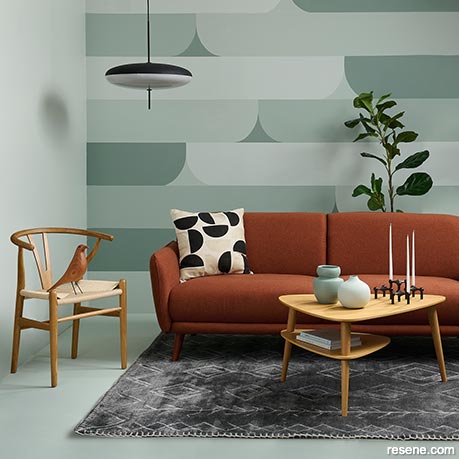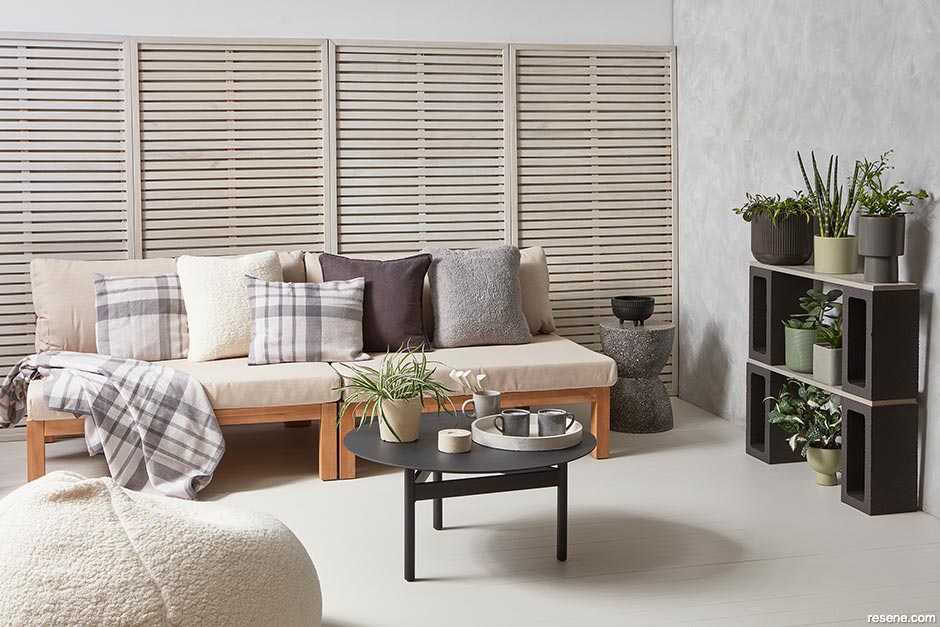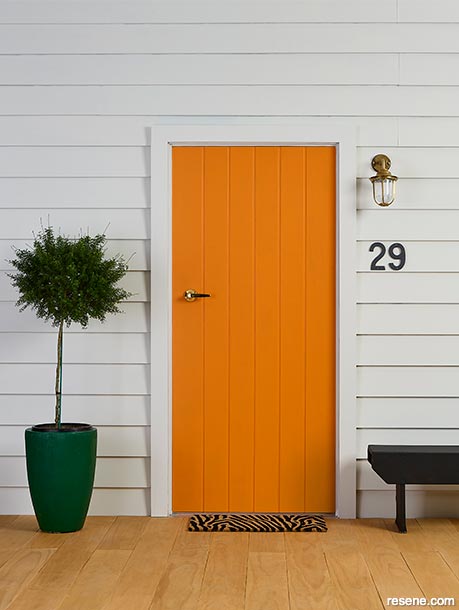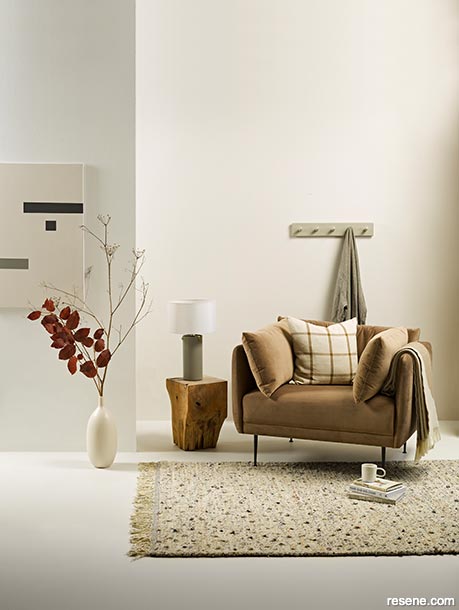From the Resene decorating blog
Congratulations on the amazing new painted finish on your home exterior or interior walls! After the time and effort that went into choosing colours, preparing surfaces and painting, you want to make sure to take care of your paint finish so it looks its best for as long as possible.

Protect all your hard work creating stunning painted interiors with gentle cleaning and by keeping rooms dry and well-ventilated. This geometric design on the back wall is painted in Resene Robin Egg Blue, Resene Half Robin Egg Blue, Resene Quarter Robin Egg Blue and Resene Smoky Green. The left side wall is painted in Quarter Robin Egg Blue while the floor is in Resene Half Robin Egg Blue. On the table the vases are Resene Smoky Green (left) and Resene Quarter Robin Egg Blue. Sofa, half circles cushion, coffee table, floor lamp and Eames bird from Nood, pendant lamp, candle holders and tapers from Good Form, striped circle cushions and rug from Freedom, chair from Mood Store. Project by Laura Lynn Johnston, image by Bryce Carleton.
If you’ve taken the time to do your surface preparation (you can find excellent guides to preparing different surfaces on the resene website or ask a paint expert in your local Resene ColorShop), your paint finish should last for years, but there are some simple steps you can take now and then to ensure the longest lasting finish.
Top tip: Avoid bumping or cleaning the paint finish until at least four weeks after it’s been painted to allow it plenty of time to cure fully.
When it comes to cleaning painted surfaces, particularly inside, the key phrase to keep in mind is ‘go gently’, particularly for matte or low-sheen finishes.
For regular day-to-day cleaning avoid scrubbing your interior walls and give them a gentle wipe with a damp cloth or sponge. If you have specific stains that need removing – or perhaps a delightful but unplanned artwork from a younger member of the family, start with a product designed specifically for interior paint cleaning like Resene Interior Paintwork Cleaner. Dilute the cleaner to the instructions on the bottle, and to match the level of cleaning required.
Apply a small amount of cleaner to a lint-free cloth – don’t saturate it as that can cause drip marks, or spray the cleaning solution on to the target area.
Clean by gently wiping the area around the stain or mark you’re trying to remove and working towards it, feathering out the edges as you go.
Salt, moss, and road pollution are some of the pollutants that can settle on your exterior paintwork. An annual wash of your home exterior is a good way to keep on top of the grime and protect your paint.
Don’t be tempted to blast dirt off painted surfaces with a water blaster as you may damage the paint and, if you have wooden weatherboards, could damage the surface of your exterior cladding.

Instead use a cleaning solution designed for exterior painted surfaces and apply with a soft broom. Resene Paint Prep and Housewash will give you a quick freshen up while Resene Deep Clean is a slower acting cleaner good for discoloured concrete or plaster finishes and mossy walls.
Top tip: Although bleach is another effective way to remove mould and moss from painted surfaces it can cause your paint finish to discolour.
Excess moisture can impact the life of your interior paint finish, so keep spaces ventilated when paint is drying. This will help excess moisture evaporate and ensure your paint cures properly.
It’s also important to make sure your prepared surfaces are completely dry before any paint is applied. This is particularly important if you’re painting porous exterior surfaces such as plaster. Paint won’t cure over a damp surface and is likely to blister and bubble.
If you have a damp house or suffer from condensation on your windows in the mornings, a dehumidifier can help remove moisture from the air, protect your paint and prevent mildew developing.

Gentle cleaning and choosing the right paint for the right areas helps keep painted exteriors looking good for as long as possible.
This bright orange door is painted in Resene Hyperactive complemented by weatherboards in Resene Merino, and a deck in Resene Woodsman Natural. The plant pot is Resene Kaitoke Green, the bench is Resene All Black, and even the stripes of the zebra doormat are painted in Resene Hyperactive and Resene All Black. Plant and doormat from Mitre 10, light from Lighting Plus. Project by Sarah Kolver, image by Bryce Carleton.

Once you’ve finished your painting don’t bump against it or clean it for at least four weeks to ensure it fully cures.
Back wall painted in Resene Merino, while the front wall is Resene Alabaster and the floor is Resene White Pointer. The DIY artwork is Resene Quarter Tea, Resene Double Ash and Resene Half Truffle. The tall vase is Resene Parchment, the lamp is Resene Tapa, the jug base is Resene Putty and the wall hooks are Resene Double Ash. Dried spray from Flux Boutique, side table from Indi Home Collective, armchair and rug from Contempa, grid cushion and gown from Citta, throw from Sunday Home Store, mug and two top books from Sunday Home Store, ‘The Tiny Mess’ book from Paper Plane. Project by Gem Adams, image by Melanie Jenkins.
Painted finishes on both interior and exterior surfaces can fade if constantly subjected to direct sunlight. The changes might be gradual, but then you’ll go to move a picture on the wall or a piece of furniture and notice a change in tone.
Resene paints are designed to resist fading but to further protect areas of direct sun, use a final topcoat of Resene Clearcoat UVS protective glaze. It’s particularly useful on bright or bold shades on exterior surfaces. Think of it like sunscreen for your paint finish.
Lime staining can sometimes be mistaken for paint fade as lime leaches from the underlying surface, particularly plaster, to leave a pale deposit on the top coat. Paint plaster surfaces with a lime blocking agent like Resene Limelock before painting your topcoat to prevent lime leaching.
Darker paint shades in direct sun on exterior surfaces can also start to bubble as they absorb more heat. This heat absorption can even cause damage to the underlying surface material. Resene CoolColour helps prevent this heat damage by reflecting rather than absorbing heat.
There are regular small maintenance tasks you can do to make sure your stained surfaces like fences and decks look their very best for as long as possible.
Keep the surface free of debris and dirt as much as possible with regular sweeping. Apply Resene Deep Clean once or twice a year to keep surfaces cleaner – simply spray on and leave. Cleaning more often may be a good idea if your section and deck have shady areas that are prone to mould and mildew.
To clean an unstained wooden fence, generously apply the Resene Timber and Deck Wash with a wide brush. Leave for about 15 minutes and scrub with a brush. If your fence is already stained and you just want to maintenance clean it, use Resene Deep Clean instead as Resene Timber and Deck Wash will remove the stain.


March 01, 2022
For more advice on looking after your painted and stained project, see the Resene Caring for your paint finish information on the Resene website.
Book a colour consult | Ask a Colour Expert | Ask a Paint Expert
Resene's decorating blog
Paint your home beautiful! Discover the latest decorating trends, tips and colour news.
![]()
Previous «
Creating a nature-inspired interior
![]()
Blog home
View the latest trends, tips and news
![]()
» Next
Design ideas for maximum storage